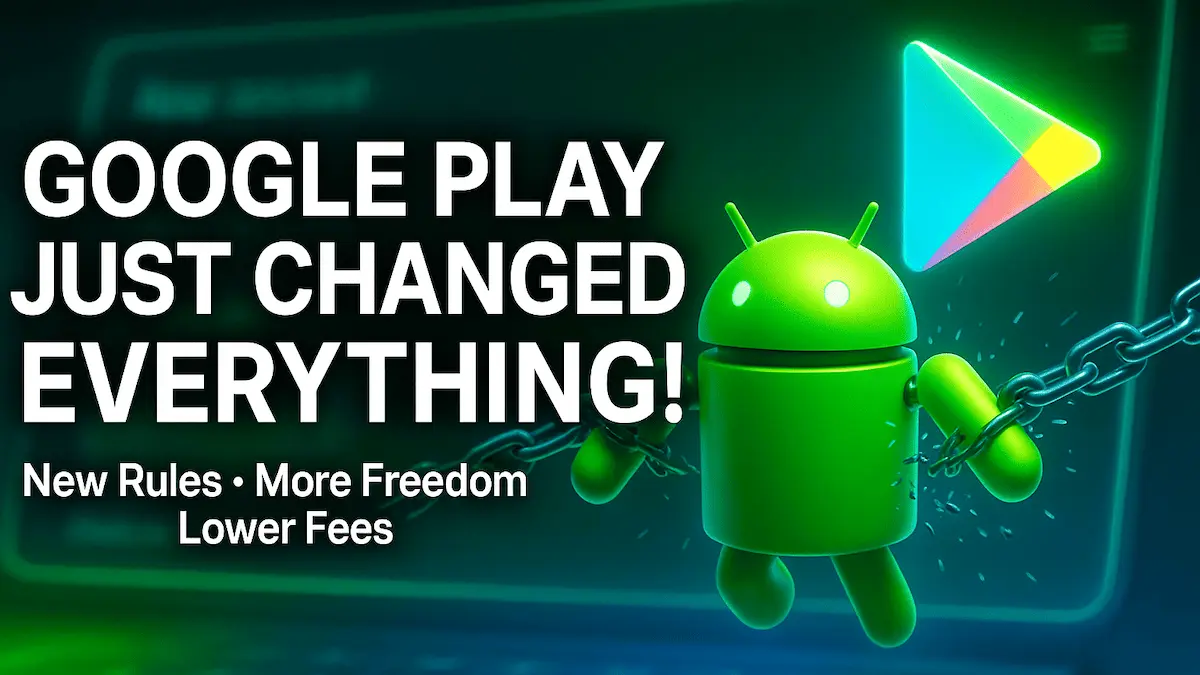
Google Play has announced major changes after its global settlement with Epic Games. Android developers can now use alternative payments, third-party app stores, and flexible pricing models — marking a new era of freedom for app creators worldwide.
This is big. Like really big.
Google just announced massive reforms to the Play Store as part of its global settlement with Epic Games, and honestly — this could change the entire Android ecosystem as we know it.
If you’ve been building Android apps, get ready. The rules of the game are shifting.
🔍 What’s Changing (and Why It Matters)
Let’s break down what’s new — and how it actually affects you as a developer.
💳 1. Developers Can Now Use Alternative Payment Methods
For years, Google forced everyone to use Google Play Billing, which meant you paid a fee (up to 30%) for every transaction — in-app purchases, subscriptions, upgrades, everything.
Now, developers can direct users to external payment options.
Example:
Imagine you have a note-taking app with a premium version. Before, users had to buy it through Play Billing. Now, you can show a button like “Pay securely on our website” — and charge users directly.
You keep more of your revenue, and users get flexibility.
Of course, Google still takes a small service fee (around 4%), but it’s nothing compared to the 15–30% cut they used to take.
💡 Translation: You finally control your own checkout flow — no more forced billing.
🏪 2. Third-Party App Stores Will Be Easier to Install and Use
This one’s wild.
Google is opening up Android globally to third-party app stores — like Samsung Galaxy Store, Amazon Appstore, Huawei AppGallery, and even indie ones.
Example:
Let’s say you build a gaming platform and want to distribute apps without relying on Google Play. Now, users can install your custom app store more easily, without scary warnings or complex permissions.
This could create a wave of niche app ecosystems — from gaming to education to enterprise.
💡 Translation: Android just became more “PC-like.” You can build and run your own store if you want.
💰 3. Transaction Fees Are Dropping — Capped at 9% or 20%
Google’s notorious for high fees — but that era’s ending.
With this reform, transaction fees will be capped at 9% (for external payments) or 20% (for Play Billing) depending on your model.
Example:
You sell a $10 in-app item.
Previously, you might have earned just $7 after Google’s cut.
Now, depending on your setup, you could earn $8–$9.10 per transaction.
That’s a significant margin boost for indie developers and startups.
💡 Translation: You keep more of your money. Period.
🔓 4. No More Exclusive Deals with Hardware Manufacturers
Google used to have certain exclusive partnerships that gave OEMs (like Samsung or Xiaomi) special advantages or pre-installation deals.
That’s ending.
Now, developers and companies can negotiate directly with hardware partners — or even pre-install their apps on devices more freely.
Example:
You’re building a fitness app and want it to ship pre-installed on smartwatches. Previously, that door was locked behind corporate agreements. Now, you can approach brands directly.
💡 Translation: The Android ecosystem is getting democratized.
🧾 5. Developers Can Freely Set Their Own Pricing & Billing Models
This might be my favorite part.
Google is dropping several restrictions on how developers structure pricing.
Example:
Want to offer a “pay once, lifetime access” plan instead of a subscription? You can.
Want to use your own tiered pricing or regional discounts? Go for it.
Want to switch between different payment gateways like Stripe or Razorpay? Totally fine.
💡 Translation: You’re no longer boxed into Google’s one-size-fits-all business model.
🌍 Why This Is Huge for the Developer Community
This is more than just policy updates.
It’s a philosophical shift.
For years, Android developers felt like second-class citizens compared to iOS devs in terms of revenue and control. But now? The balance is shifting.
Android is becoming a true open business platform again — flexible, global, and developer-first.
And for people working with KMM (Kotlin Multiplatform Mobile), this is even bigger news.
You can now build one shared codebase and distribute it across multiple app stores with custom billing models — all legally and officially supported.
Imagine the new possibilities:
-
Build once, launch on Play Store, Samsung Store, and Amazon Store.
-
Offer direct website payments without extra SDK headaches.
-
Monetize globally with your own terms.
That’s freedom.
🧠 My Take as a Developer
I’ve published 100+ apps over the years, and I can tell you this: the hardest part has never been coding — it’s always been distribution and monetization.
Google’s new reforms finally address both.
For indie devs, this could be the start of a fairer, more open ecosystem.
For startups, it’s an opportunity to innovate with pricing and reach.
And for the entire Android community — it’s a breath of fresh air after years of tight control.
Sure, we’ll still have to see how these policies roll out in real life. But for once, it feels like we’re heading in the right direction.
💡 Final Thoughts
This settlement isn’t just about Epic Games.
It’s about every Android developer who’s ever felt boxed in by restrictive rules.
Now, we can build freely.
We can choose how we charge users.
We can decide where to publish and how to grow.
That’s the kind of creative freedom Android was always supposed to have.
The future of app development just got a little brighter. ✨
Made with ❤️ by codewithpk.com
Keep exploring. Keep building. Keep shipping.
